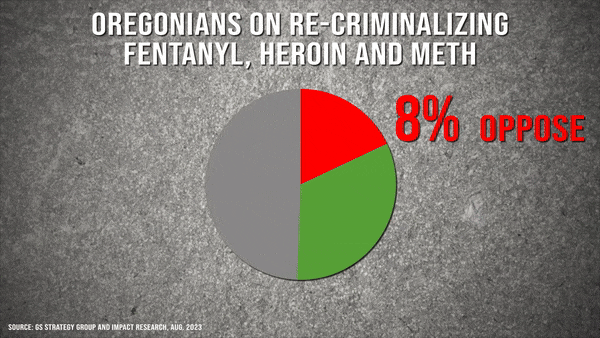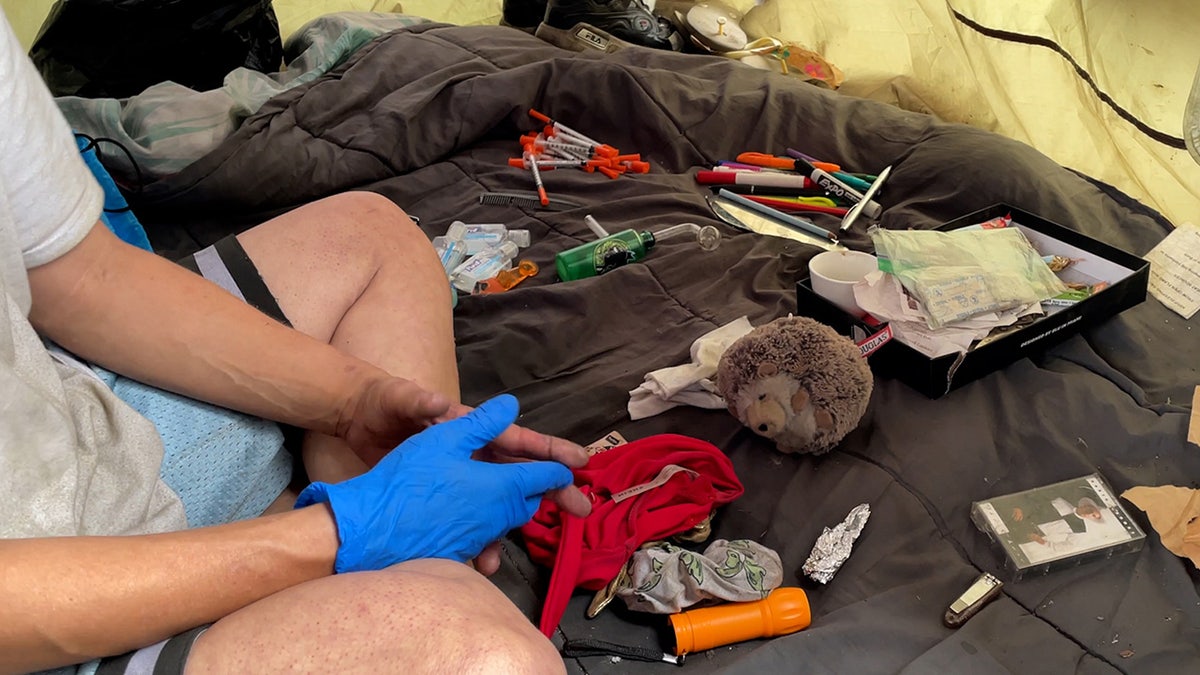Crisis in the Northwest: ‘Killing the mentally ill for a dollar a pill’
Three years ago, Oregon did away with criminal sanctions for drug possession. But after a surge in overdoses and open-air use, the state is poised to re-criminalize drugs.
This story is part of a series examining the drug and homeless crises plaguing Oregon. Read part one.
PORTLAND, Ore. – People sleeping — or passed out — in downtown Portland hardly get a second glance. Most pedestrians keep their eyes trained straight ahead as they walk past clouds of fentanyl smoke or slumped figures with lolling heads. Maybe they cross the street or look sidelong at someone who starts shouting or throwing things.
But Nikki is different.

A man sleeps in front of a business on January 10, 2024, in Portland, Oregon. (Hannah Ray Lambert/Fox News Digital)
CRISIS IN THE NORTHWEST: ARE VOTERS 'BEYOND A TURNING POINT' AFTER DECADES OF PROGRESSIVE POLITICS?
"Are you okay? Are you sleeping?" she called out, approaching a cocooned form next to the light rail tracks. Somewhere inside the sleeping bag, a man grunted in response.
Nikki, who has been homeless for two and a half years, repeats this process any time she sees someone lying on the ground, making sure they're responsive.
Fentanyl "literally makes people so careless that they will stand over someone who is dead or dying and continue to get high," she said. It happened to one of her friends, a man in his mid-20s who appeared to be sleeping, but had died.
"They were gonna have a lot of life left," she added.

A person smokes a foil of fentanyl on Park Avenue in downtown Portland, Oregon on January 23, 2024. Possession of user amounts of all drugs became decriminalized in the state in February 2021 after voters approved Measure 110. The first-in-the-nation law turned possession into a Class E violation, punishable by a $100 fine. Selling and manufacturing drugs remains illegal. (Patrick T. Fallon/AFP via Getty Images)
State of emergency
Oregon has turned into a battlefield in the war over drug policy since the state became the first to decriminalize drug possession. Nearly 60% of voters approved Measure 110 but, three years later, numerous polls suggest they regret that move. And no other states have followed Oregon's lead, despite assurances from researchers and decriminalization advocates that the law is not responsible for increased addiction, overdoses and crime.
State lawmakers are poised to re-criminalize drug possession in a special legislative session that begins Monday, though Democrats and Republicans have drafted competing bills. And Oregon Gov. Tina Kotek declared a 90-day state of emergency this week in downtown Portland, where the fentanyl crisis has been most pronounced.
"Our country and our state have never seen a drug this deadly and addictive, and all are grappling with how to respond," Kotek, a Democrat, said in a release. "We are all in this together."
WATCH: FENTANYL ‘KILLING THE MENTALLY ILL FOR A DOLLAR A PILL’
WATCH MORE FOX NEWS DIGITAL ORIGINALS HERE
Fentanyl strikes fear among even longtime drug users.
"This is creating zombies," Lori, a homeless woman in Portland, told Fox News last summer. "This sh-- should be illegal because they're killing the mentally ill for a dollar a pill, because I guarantee ya, all these people have some kind of mental illness."
Michael Dusek, who uses marijuana and meth, agreed.
"They’re incoherent most of the time, they’re babbling about something to themselves quite loudly, like they can’t hear themselves," said Dusek, who has been homeless off and on since 1992. "They’re like living dead."
Overdose deaths in the state surged from 800 in 2020 to 1,394 in 2022, according to data from the Centers for Disease Control and Prevention. The overwhelming majority of fatal overdoses are now attributed to fentanyl, according to Oregon health data.
"It seems like we got all of Oregon coming, just to pick up fentanyl now," Dusek said of Portland.
Decriminalization advocates point out that fatal overdoses surged across the country beginning in early 2020, not just in Oregon. Many analysts attribute the spike to isolation and despair during the coronavirus pandemic.
Nikki said she has revived 32 people in the past year, collecting as many doses of naloxone as she can from clinics, shelters and even places where citizens have "just nailed a box to a tree or to a wall and keep it stocked with Narcan."
It seems like we got all of Oregon coming, just to pick up fentanyl now.
Most fentanyl users Fox News spoke to were difficult — if not impossible — to understand. One woman chattered breathlessly while absently sorting syringes inside her tent, one hand protected by a blue latex glove. A 27-year-old man muttered that he was originally from Idaho, then lived on the Yakama Indian Reservation before a family member dropped him off in Portland so he could "live homeless and do drugs."
"Most of them are mentally ill, and the families don't wanna take care of them," Lori said. "Or they're sick and old and their families don't take care of 'em."
The rise of fentanyl
Methamphetamine was historically Oregon’s drug of choice. But around 2018, law enforcement started to see a trickle of fentanyl, and then a surge, outpacing cocaine, heroin and meth. The small blue pills looked like Oxycodone and were filling the void left after states cracked down on opioid prescriptions.
And they were cheap to produce.
"It doesn't take a whole lot of fentanyl to meet the supply side for particular users to give them the effects that they want," said Chris Gibson, executive director of the Oregon-Idaho High Intensity Drug Trafficking Area (HIDTA).
The number of pills law enforcement seized soared from about 100,000 in 2019, to more than 3 million in 2022, according to HIDTA's annual report. And while preliminary data from 2023 shows the increase in pill seizures slowing, powder seizures more than tripled last year. Police who participate in the HIDTA reported finding more than 180 kg (nearly 400 lbs) of fentanyl powder, Gibson said.
"When you start thinking about the fact that it's estimated that two milligrams of fentanyl is a lethal dose to a new user, we start seeing the dangers of that," Gibson said.
The ingredients to make fentanyl are typically shipped from China to Mexico, Gibson said, then the finished product makes its way up the I-5 corridor from border to border, fanning out along the way.
"Oregon can't control the southern border, but we have Honduran cartel members all in our urban areas pushing deadly fentanyl," Clackamas County Commissioner Ben West said. "We can't control that. But that costs Oregonians lives, and it causes a lot of criminality and despair."
But Oregon can control its drug policies, West said, and "elections have consequences."
The end of the decriminalization experiment?
Measure 110 made possession of user amounts of all drugs, including fentanyl, a Class E violation, punishable by a $100 fine that could be waived if the suspect called a hotline and completed a treatment assessment. But it quickly became apparent that drug users were not calling the hotline or paying the fine.
The other major part of the law — and one that many decriminalization critics want to keep — was redirecting a large chunk of the state's marijuana tax revenue to pay for addiction services, theoretically improving access to treatment. But that rollout was beleaguered by bureaucratic flubs and a tight implementation timeline.
Oregon approved $264 million in grants for more than 200 service providers as of December, according to the most recent audit from the Secretary of State’s office, which found issues with oversight and noted it has been difficult to demonstrate the new law's effectiveness.
Many Oregon voters feel duped.

Numerous surveys show Oregonians support re-criminalizing hard drugs and making treatment mandatory, not voluntary, in order to avoid jail time. (Ramiro Vargas/Fox News Digital)
"I voted for it because I thought it would reclassify drug crimes and allow people to get into treatment, and then it would be treatment-focused," Kristin Olson, an attorney and host of the Rational in Portland podcast, previously told Fox News.
But the majority of users who take advantage of Measure 110 funds are accessing harm reduction supplies like clean needles, pipes and Naloxone. Residential treatment and detox centers were not prioritized in grant spending, raising alarm among some providers, according to a recent audit of the measure.
"In Oregon, it's really easy to get high and really, really hard to get treatment," West said. "You would think we would want to reverse that culturally."
Providers that "required sobriety for housing or supportive employment" were more likely to have their grant applications denied for not being "in line" with the spirit of the law, the audit also found.
"There's a lot of money that is being put into out of sight, out of mind programs," said Matt Maceira, who suffered from addiction and frequent homelessness for 27 years. "The money's wasted is what I'm saying."
In Oregon, it's really easy to get high and really, really hard to get treatment.
After getting sober, Maceira founded Be Bold Street Ministries, a Christ-centered nonprofit. Volunteers can often be found praying with those living in one of Oregon's biggest encampments, just across the Wilamette River from the state capitol. They tell them about shelter and detox options and, on a cold Friday in January, helped a 28-year-old meth user call and register for treatment.
Maceira opposed Measure 110 from the start.
"The decriminalization of deadly, mind-altering substances — you know what that will never produce? Decreased crime, increased public safety and lives saved," he said. "But that's what was promised."
He said drug use is rampant at the low-barrier shelters prioritized by Measure 110.
"People are dying in those places. I've done celebrations-of-life services for people that have overdosed at low-barrier shelters," he said, adding that he would rather see providers require sobriety.

Matt Maceira hugs a friend on January 12, 2023, in the homeless encampment at Wallace Marine Park in Salem, Oregon. Maceira lived in the camp when he was homeless and now comes back to share the gospel and help those who are ready to enter treatment for addiction. (Hannah Ray Lambert/Fox News Digital)
"Letting people use methamphetamine, fentanyl and heroin or any other deadly substance is not compassionate," he said. "Having a rule that says, 'Hey, government money is paying for this, you can't use drugs here,' is a really loving message. Like, I actually care about you. I don't want to see you be another statistic."
Measure 110 a top priority in special legislative session
Democrats, who control both chambers of the state legislature, have signaled they want to make drug possession a Class C misdemeanor, the lowest crime classification available in the state. Their proposal offers numerous off-ramps for those caught with drugs to avoid charges.
Republicans, meanwhile, released a bill that would make possession of drugs like fentanyl, heroin and meth a Class A misdemeanor and would require treatment to avoid jail. If convicted, drug users could face up to a year behind bars, a $6,250 fine, or both. They argue the stiffer penalties are necessary to incentivize people to get clean.
Lawmakers will meet for a short session beginning February 5. It’s not clear whether the sides can compromise.
"We’re not looking to put a Band-Aid on something," GOP Rep. Lucetta Elmer said. "We’re looking to actually see effective change."
Elmer is particularly passionate about addressing youth addiction.
"A tragedy that came out of Measure 110 is that there was no differentiation between youth and adults," she said. "If a youth is caught with alcohol, they actually would get a minor in-possession charge. But if that same youth is caught with fentanyl, under Measure 110, that's decriminalized."
Danielle Bethell, president of the Association of Oregon Counties, said she doesn't know any county commissioners who favor locking up drug addicts.
"That's just not the narrative," Bethell said. "The reality, though, is that everybody who has an addiction needs help. And most of them, if not all, need a nudge. And that nudge doesn't exist anymore."
‘THIS IS THE WILD WEST’: LONG POLICE WAIT TIMES IN MAJOR CITIES LEAVE VICTIMS FEELING HELPLESS
Yamhill County Sheriff Sam Elliott said his rural community had a "very successful drug court program" that helped people recover from addiction and avoid a felony conviction. Now, that's essentially nonexistent.
"When you give them a violation citation that they don't have to appear on . . . they don't come back in and have that interaction with those resources," he said.
Decriminalization advocates don’t want change, though, arguing the law is "doing its part to address drug use and addiction with a health approach," according to the George Soros-backed Drug Policy Alliance, which poured millions into the campaign for Measure 110.
"Our opponents are using it as a scapegoat for other, longstanding issues such as homelessness, crime, and public disorder," the group's website reads. The alliance did not respond to multiple interview requests.
Researchers at New York University's Grossman School of Medicine wrote in a September paper that they found no evidence of an association between decriminalization and fatal overdose rates in Oregon.

A woman sits inside her tent filled with syringes, a pipe, foil and other drug paraphernalia in Portland, Oregon, in July 2023. (Hannah Ray Lambert/Fox News Digital)
CLICK HERE TO GET THE FOX NEWS APP
Gibson, with the HIDTA, and Elliott both said it is difficult to attribute fentanyl’s rise in Oregon to Measure 110. The law took effect during the coronavirus pandemic, when overdose rates rose nationwide. And fentanyl has been ravaging east coast communities like Philadelphia’s notorious Kensington neighborhood for nearly a decade.
But Oregonians and their representatives seem unwilling to continue the experiment.
"I really think there is an opportunity to completely course-correct," Maceira said, by "not allowing people to use those deadly substances or be okay with it."
Ramiro Vargas contributed to the accompanying video.







